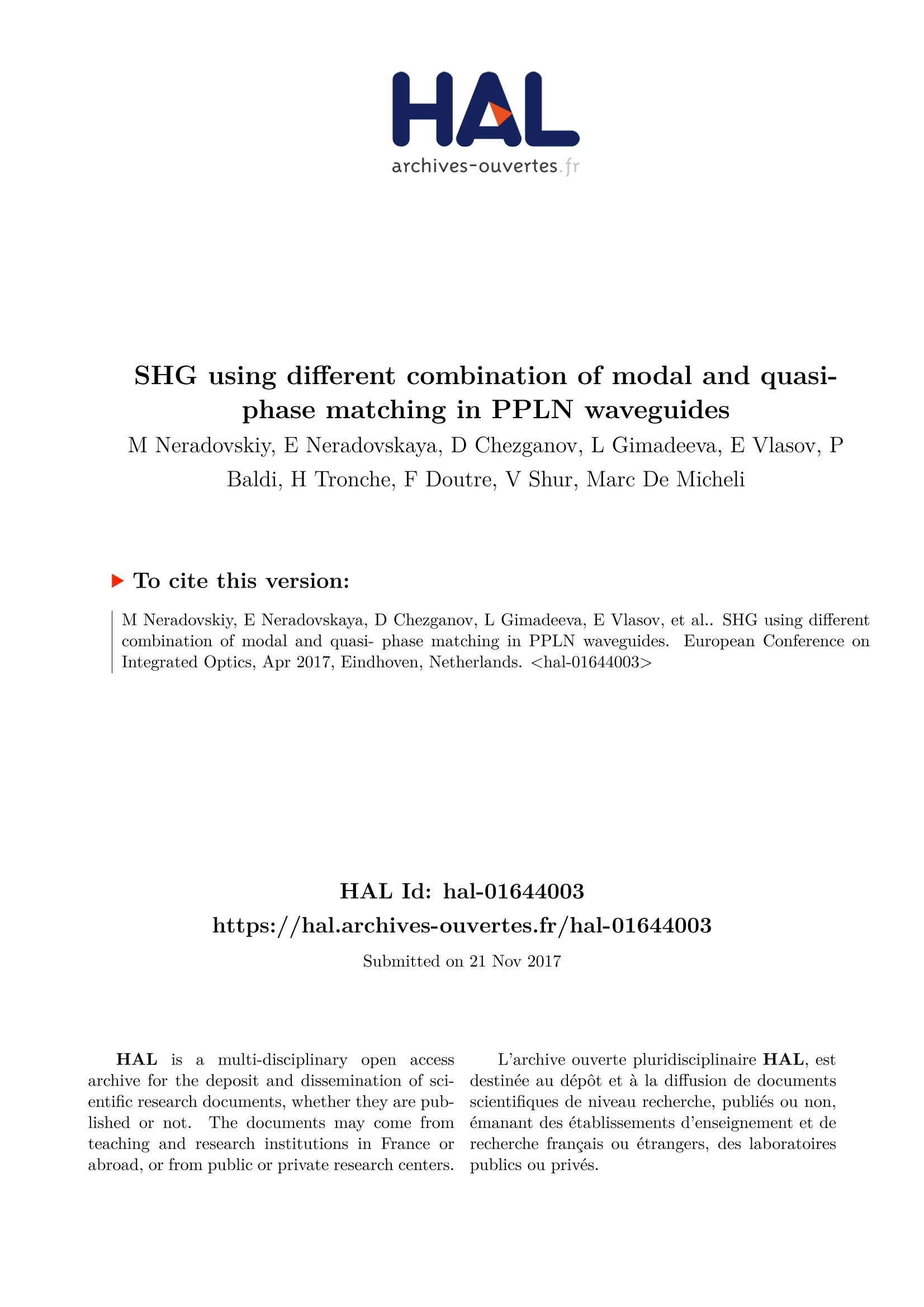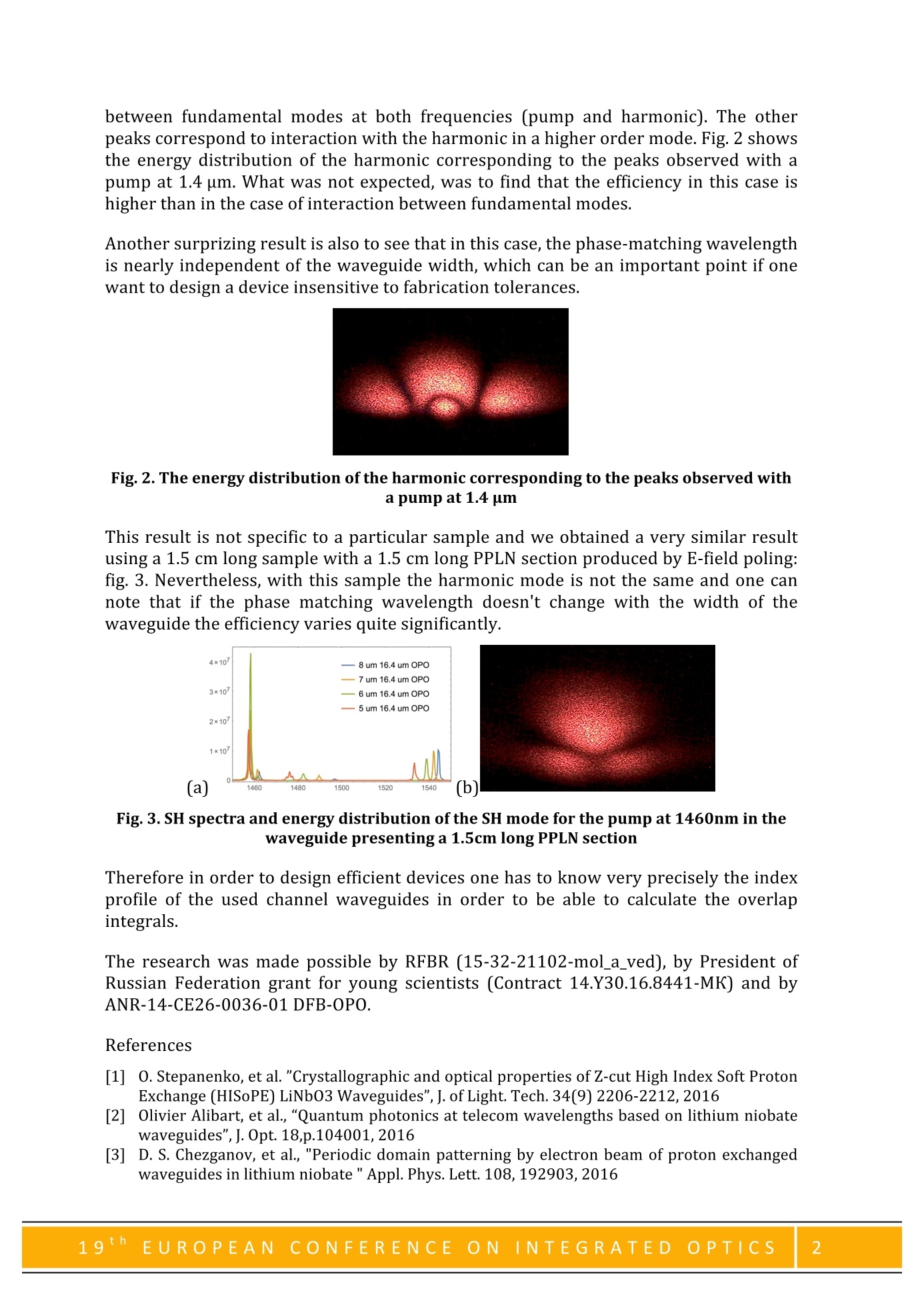方案详情
文
利用Ekspla公司的千赫兹可调谐激光器NT242,对PPLN波导中模态和准相位匹配的不同组合及其和倍频谐波发生(SHG)过程的关系进行了研究。
方案详情

EUROPEANCONFERENCE ONNTEGRATED OPTICS SHG using different combination of modal and quasi-phase matching in PPLN waveguides M Neradovskiy, E Neradovskaya, D Chezganov, L Gimadeeva, E Vlasov, PBaldi, H Tronche, F Doutre, V Shur, Marc De Micheli To cite this version: M Neradovskiy, E Neradovskaya, D Chezganov, L Gimadeeva, E Vlasov, et al.. SHG using differentcombination of modal and quasi- phase matching in PPLN waveguides. European Conference onIntegrated Optics, Apr 2017, Eindhoven, Netherlands. HAL Id: hal-01644003https://hal.archives-ouvertes.fr/hal-01644003 Submitted on 21 Nov 2017 HAL isa multi-disciplinary openaccessarchive for the deposit and dissemination of sci-entific research documents, whether they are pub-lished or not.The documents may come fromteaching and research institutions in France orabroad, or from public or private research centers. )-S L’archive ouverte pluridisciplinaire HAL, estdestinee au depot et a la diffusion de documentsscientifiques de niveau recherche, publies ou non,emanant des etablissements d'enseignement et derecherche francais ou etrangers, des laboratoirespublics ou prives. SHG using different combination of modal and quasi-phase matching in PPLN waveguides. M. NERADOVSKIY12,E. NERADOVSKAYA,D. CHEZGANOV,L.GIMADEEVA?E. VLASOV,P.BALDI,H. TRONCHE,F. DOUTRE,V. Ya. SHUR, M. P. De MICHELI1Universite Cote d'Azur, CNRS, Nice Physical Institut, Parc Valrose 06100 Nice, France2Institute of Natural Sciences, UrFU, 19 Mira Str., Ekaterinburg 620000, Russia*marc.de-micheli@unice.fr Theoretically, increasing the mode confinement is the way to go to improve thenonlinear efficiency, and we are actively working in this direction [1], but up to knowthere are still fabrications issues to solve to get low loss, highly confining waveguideswith preserved nonlinearities in PPLN. Therefore, we are still intensively studying theSPE technique and despite our experience and the numerous devices we have been ableto develop for Quantum Communications [2], precisely controlling the spectrum andthe efficiency in SHG experiments is still an issue. Our devices are designed to be usedat low CW power, but in order to characterise them more precisely, we add acharacterisation step using a pulsed OPO NT242 from EKSPLA which emits 5ns pulsesat 1kHz rep. rate and is tuneable from 210 to 2600nm. Using a 1.5 cm long sample in which the PPLN section obtained by e-beam writing [3] was1.5mm long and the waveguides produced by the SPE process using a proton sourcecomposed of Benzoic Acid and 3.1% Lithium Benzoate melted at 300C, we obtained thenormalized spectra reported in fig.1a. In this picture, we can see that we obtained thesame results with the OPO and with a tuneable monomode CW laser (Tunics T100S-HP]. Fig. 1. (a) Comparison of the SHG normalized spectra obtained with the OPO and a CWmonomode tunable laser and (b) SHG spectra showing the harmonic signal obtained withdifferent combinations of modal and quasi-phase matching. Using an intense broadly tuneableesource,, we expected to find the differentcombinations of modal and quasi-phase matching which can be observed in fig.1b. Thesignal observed for a pump wavelength of 1.55 um correspond to the interaction between fundamental modes at both frequencies (pump and harmonic). The otherpeaks correspond to interaction with the harmonic in a higher order mode. Fig. 2 showsthe energy distribution of the harmonic corresponding to the peaks observed with apump at 1.4 um. What was not expected, was to find that the efficiency in this case ishigher than in the case of interaction between fundamental modes. Another surprizing result is also to see that in this case, the phase-matching wavelengthis nearly independent of the waveguide width, which can be an important point if onewant to design a device insensitive to fabrication tolerances. Fig. 2. The energy distribution of the harmonic corresponding to the peaks observed witha pump at 1.4 um This result is not specific to a particular sample and we obtained a very similar resultusing a 1.5 cm long sample with a 1.5 cm long PPLN section produced by E-field poling:fig. 3. Nevertheless, with this sample the harmonic mode is not the same and one cannote that if the phase matching wavelength doesn’t change with the width of thewaveguide the efficiency varies quite significantly. (b) Fig. 3. SH spectra and energy distribution of the SH mode for the pump at 1460nm in thewaveguide presenting a 1.5cm long PPLN section Therefore in order to design efficient devices one has to know very precisely the indexprofile of the used channel waveguides in order to be able to calculate the overlapintegrals. The research was made possible by RFBR (15-32-21102-mol_a_ved), by President ofRussian Federation grant for young scientists (Contract 14.Y30.16.8441-MK) and byANR-14-CE26-0036-01 DFB-OPO. References [1]O. Stepanenko, et al."Crystallographic and optical properties of Z-cut High Index Soft ProtonExchange (HISoPE) LiNb03 Waveguides", J. of Light. Tech. 34(9) 2206-2212,2016 [2]Olivier Alibart, et al.,“Quantum photonics at telecom wavelengths based on lithium niobatewaveguides",J.Opt.18,p.104001,2016 [3]D. S. Chezganov, et al., "Periodic domain patterning by electron beam of proton exchangedwaveguides in lithium niobate " Appl. Phys. Lett. 108,192903,2016 hEUROPEAN CONFERENCE ON IINTEGRATED OPTICS Theoretically, increasing the mode confinement is the way to go to improve thenonlinear efficiency, and we are actively working in this direction [1], but up to knowthere are still fabrications issues to solve to get low loss, highly confining waveguideswith preserved nonlinearities in PPLN. Therefore, we are still intensively studying theSPE technique and despite our experience and the numerous devices we have been ableto develop for Quantum Communications [2], precisely controlling the spectrum andthe efficiency in SHG experiments is still an issue. Our devices are designed to be usedat low CW power, but in order to characterise them more precisely, we add acharacterisation step using a pulsed OPO NT242 from EKSPLA which emits 5ns pulsesat 1kHz rep. rate and is tuneable from 210 to 2600 nm.
确定



还剩1页未读,是否继续阅读?
北京欧兰科技发展有限公司为您提供《PPLN波导中模态和准相位匹配的不同组合检测方案(激光产品)》,该方案主要用于其他中模态和准相位匹配的不同组合检测,参考标准--,《PPLN波导中模态和准相位匹配的不同组合检测方案(激光产品)》用到的仪器有
相关方案
更多
该厂商其他方案
更多









